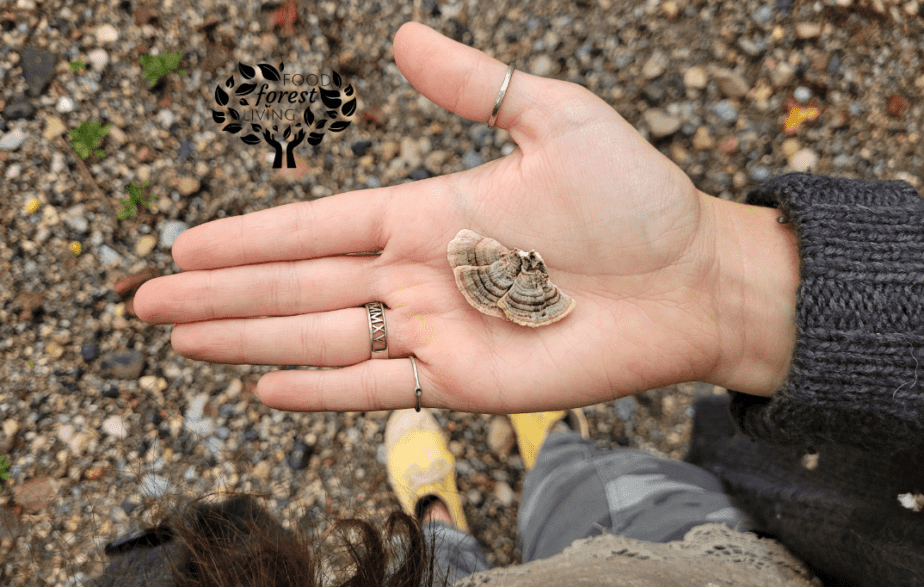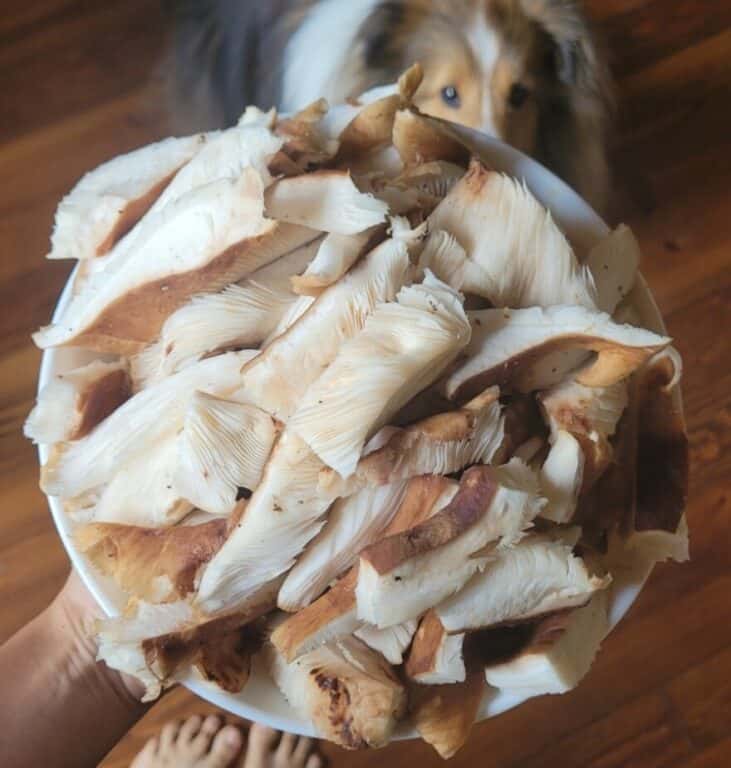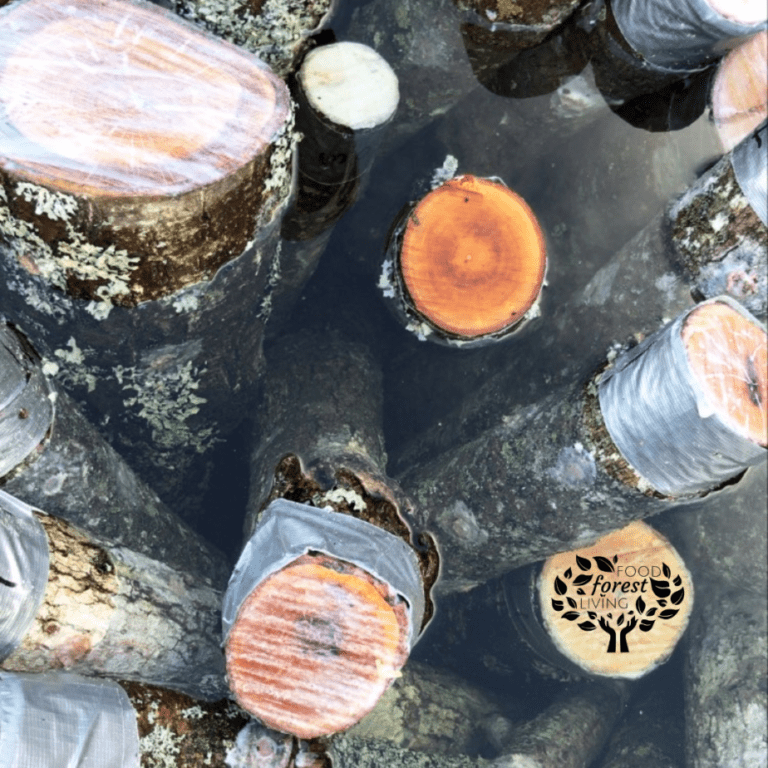This post may contain affiliate links. If you use these links to buy something we may earn a commission. Thanks.
How is it not worth having $5+ bills popping out of your mushroom logs 3-5 times per season for 3-9 years?
We just saw a SINGLE portobello mushroom cap available for $7.50 at the grocery store. Shiitake mushroom logs will produce 4-12 mushrooms per log in a single flush. Your logs might not be popping out portobellos, but shiitake are meatier, more expensive to buy at a grocery store, and just as delicious.
It is entirely worth growing mushroom logs. Mushroom logs give long-term quality and decent quantity yields. Gourmet mushrooms cost a lot in the market, yet pay for themselves when grown at home. You can’t get mushrooms for a better price than making mushroom logs.
Mushroom logs take upfront work and investment. But once you have the tools, experience, and mushroom strains, the next round is a cheaper and easier process.
Even if you make mushroom logs just one time they pay you back for a long time. Read on to fill your cup of expectations.
Related: What it Costs to Grow Mushrooms (Indoor vs Outdoor)
Do mushroom logs keep producing?
Yes, it’s what I love about mushroom logs. It’s why we make mushroom logs. The work and waiting period combined is completely worth their generous long-term production. So, just how long do mushroom logs last?
On average, mushroom logs keep producing for 3-7 or more seasons. The precise length of time they produce depends on the mushroom type, log size, conditions, and good maintenance.
The larger the log, the longer it will last. So, what sizes are you okay with carrying around?
How long do you get mushrooms from a mushroom log?
While it’s nice to know that your mushroom logs will keep producing—they don’t just have mushrooms popping out of them 100% of the time. We have noticed each of our mushroom strains will pin and successfully fruit at their desired temperatures. So, what fungi fruiting timeline can we expect from a single log and their flush intervals?
A single mushroom log will produce for a year per inch of log diameter and gives 2-5 flushes per year. For example, a 6-inch log will fruit for about 6 years and multiple times each season. On average, a single flush from a single log will give you a good meal of mushrooms.
While it has been declared by most sellers that every inch of diameter is the year count of production, it likely isn’t 100% accurate in all cases. Nothing should be expected as so!
So far, none of our logs have yet expired and they are 4 or more inches! I’ll be sure to update you when they do.
Expect a fluctuation of yearly output based on log size, species, and seasonal temper.
If you love eating mushrooms as much as we do, err on the side of more mushroom logs!

How long do mushrooms take to grow on logs?
When you inoculate a log, no matter the conditions, fruiting will not occur until they have populated the substrate. The substrate is the log. The size of the log influences how quickly it’s colonized.
It takes 6-24 months for a mushroom log to colonize and begin fruiting. Logs produce 2-5 times per year for 3-9 years. Each flush takes days or hours for mature fruit to develop and minutes to harvest. Mushroom type, log size, and conditions affect colonization time and fruit development.
The turkey tail logs we made in the spring of 2020 began to produce in the spring of 2021. Our shiitake mushroom logs were made at the same time but began to fruit in the fall of 2021. The difference between them was mushroom type and log size.
Turkey tails are vigorous growers. They also had less medium to colonize.
How many mushrooms do you get from a log?
Since there are so many factors involved, every log will give a different amount of mushrooms. Since we have determined all the averages above, we can confidently give you an idea of how many mushrooms to expect from a single log.
To cook two seasonal meals per week you’ll need 16 mushroom logs. Each meal can support 2-4 people. If you want mushrooms during off-seasons such as summer and winter, double up on logs so you can dehydrate or freeze batches from each flush.
The reasoning behind needing 16 logs for two meals per week is based on the rest period between soaking.


This article was originally published on foodforestliving.com. If it is now published on any other site, it was done without permission from the copyright owner.
When we soak our logs, they sit in the water for 24 hours. When we take them out, it takes 1-2 weeks to fruit, and they need at least 8 weeks of rest from the day they were retrieved from the water.
So each week you can soak 2 logs on rotation with the others. Each set of logs will be soaked every 8 weeks. It takes minutes to lift and submerge a couple of mushroom logs, and minutes to take them back out the next day.
For very little maintenance time you can have consistent meals with homegrown mushrooms.
What is the fastest-growing mushroom?
While logs are not the fastest substrate for fruiting mushrooms, the fastest-growing edible mushroom just so happens to grow well on logs!
Oyster mushrooms are the fastest-growing edible mushrooms regardless of substrate. When we compared turkey tails, chicken of the woods, shiitake, and lion’s mane on logs, oysters fruited the fastest.
Several professional mushroom growers also claim oysters as the fastest. It’s why we were interested in monitoring our logs!
Related: 9 Best Mushrooms to Grow on Logs (From Easy to Hard)
What can you do with mushroom logs?
Eating the gourmet mushrooms from your logs is their primary purpose. However, they do have many more functions than a personal food supply.
With new mushrooms logs you can:
- position them into a nice design in your garden or under a tree
- or sell them to locals
With colonized mushroom logs you can:
- harvest mushrooms to make meals
- harvest medicinal mushrooms for tea or medicine-making
With old and expired mushroom logs you can:
- allow it to decompose right where you keep it
- add the humus to a specific place in a perennial or vegetable garden
- add it to a hugelkultur bed
Something we’ve learned from experience is that mushroom logs are heavier work than it looks or seems. Be prepared for a workout when making and maintaining your mushroom logs!
Up next: How to Identify & Select Wood for Mushroom Logs (With Pics)
Recent Posts
There’s no shortage of full-sun ground covers for zone 4 climates! Each plant in this list can withstand the frigid temperatures and also enjoy the hot sun in summer. Full sun means that a plant...
There's no shortage of full sun ground covers, not even in zone 3! Zone 3 climates offer hot but short-lived summers and very cold winters. So each plant in this list can withstand the frigid...
